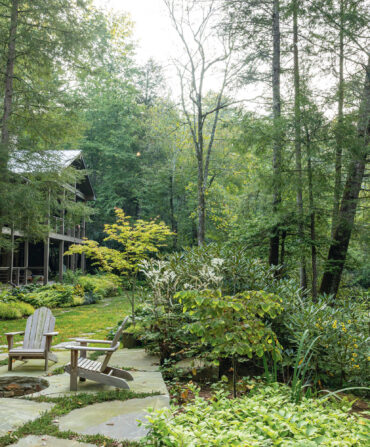Peter Thevenot found his true calling in 1988 along the winding garden paths of George Washington’s Mount Vernon. On a tour of the Virginia property with his wife, Beth, he reached out and touched his future in the form of an espaliered pear tree, sculpted to adorn a wall and heavy with fruit.
“I was overwhelmed with the thought that someone could take a seedling with the girth of a pencil and train it into something that beautiful,” recalls Thevenot (whose name is pronounced Tiv-a-no). “So I walked over to a caretaker and started asking questions.”
Two years later, the former education executive had traded business suits for blue jeans and purchased a rambling property with a farmhouse near Decatur, Tennessee, halfway between Chattanooga and Knoxville. He named it River Road Farms and prepared to launch what became the only large-scale nursery in the country that grows nothing but espalier trees.
I was tired of the traditional business world, and I was looking for some peace,” he says. “I grew up in a South Louisiana farming family, so I had some experience, and I knew if I was going to do something with trees, I needed land.
Land, sure, but more important, deeper knowledge of espalier, the art of training trees and shrubs to grow in patterns, usually symmetrical, along a flat framework. Or, as Thevenot calls it, “painting in bark and leaves.” Soon he was devouring every book he could find on the subject and had a growing landscape of small fruit and ornamental trees in the beginning stages of being shaped on long rows of wire. With an average span of four years before they become mature enough for sale, raising espaliered trees is a long game. “A piece of my soul gets passed on with these plants,” Thevenot says. “But,” he adds with a laugh, “my wife says it just gives me another thing I can control.”

Photo: Kathryn McCrary
An English barrel tunnel
Historically, from ancient Egypt to medieval Europe, espaliered trees served a functional purpose. Careful pruning makes more nutrients available to fewer branches, so the trees flower and fruit more heavily. They’re also often grown in enclosed spaces, which protect them from frost and extend their lives—some may live up to a hundred years. In the seventeenth century, the forms became highly decorative, exemplified by the tiered candelabra, latticed Belgian fence, and fan styles André Le Nôtre perfected when designing the gardens of Versailles for Louis XIV. Those are the styles Thevenot is most drawn to. “I appreciate art and architecture, and these fit the bill,” he says.
In River Road’s first year, Thevenot sold only thirty-five out of two hundred specimens. It was a disheartening start, but the business grew slowly and deliberately, much like the trees themselves. “They are a little like children,” he says. “Some grow themselves, others you have to battle and fight.” Today, Thevenot nurtures more than 3,800 trees—heirloom and hybrid pears, crab apples, magnolias, and rose of Sharon, among others—and supplies them to top landscape designers, including Ben Page of Nashville.

Photo: Kathryn McCrary
A horizontal cordon, in front of a candelabra
“I met him at least twenty-five years ago and it was an immediate ‘oh wow’ moment,” Page says. “My favorite thing to do is walk through a garden with his trees in the dead of winter to see all the beautiful bone structure. It’s so evocative of the horticulture he pursues.”
Thevenot’s trees also grow in public gardens across the nation, from the Biltmore Estate in Asheville to the Atlanta Botanical Garden. He’s even raising trees for Mount Vernon; they will replace ones that are in decline after seventy or so years of service.
Yet he’s most pleased with a call from a home gardener.
“My mission is to reintroduce espalier back into the landscape of the American garden,” he says. “Why wouldn’t you want an orchard in your backyard?”









